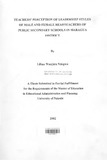| dc.description.abstract | The purpose of this study was to investigate the leadership styles used by male and
female headteachers in public secondary schools in Maragua District. In the background
to the study, the researcher looked at why good leadership in secondary schools is
important. Some cases, which showed the effects of 'high-handedness' schools, were
cited. In the statement of the problem, past studies on leadership were looked into. The
problem of poor leadership as depicted by the poor performance in examinations and
number of strikes in Maragua District secondary schools brought about the need for the
study. The hypotheses for the study were:
1. There is no significant difference between perceptions of teachers with varied
professional experience towards male and female headteachers of public secondary
schools with regard to initiating structure and consideration.
2. There is no significant difference between perceptions of teachers with varied
academic qualifications towards male and female headteachers of public secondary
schools with regard to initiating structure and consideration.
3. There is no significant difference between teachers from different school categories
towards male and female headteachersof public secondary schools with regard to
initiating structure and consideration.
4.There is no significant difference between teachers from different school types
towards male and female headteachers of public secondary schools with regard to
initiating structure and consideration
The Literature Review looked at a number of subjects namely, the nature of leadership.
Under the nature of leadership, the researcher looked at some definitions of leadership.
Some theories of leadership were also reviewed in order to conceptualize the idea of
leadership. The study also looked at gender issues on secondary school leadership and
some differences in aspects ofleadership behaviour of male and female headteachers.
The researcher used the ex-post facto design for the study. The target population was
composed of public secondary school teachers and headteachers in Maragua district. A
total of 250 teachers and headteachers were sampled using a table for determining sample
size designed by Krejcie and Morgan(1970) in Mulusa (1990).To get a representative
sample from the different school categories, stratified sampling was used. Simple random
sampling was used to select the participating headteachers and teachers. The research
instrument used was the Leadership Behaviour Description Questionnaire (LBDQ). To
analyze the data, various statistical instruments were used namely, the means, standard
deviations and Analysis of Variance (ANOVA). From the analysis, the following were
the findings:
The research findings showed that secondary school teachers tend to assign low ratings to
male and female head teachers in both initiating structure and consideration dimension.
Majority of male and female headteachers rated themselves highly in these dimensions.
Another revelation that emerged is that teachers rate male and female headteachers
significantly higher in initiating structure than in the consideration dimension
That professional experience of the teachers does not significantly affect their perceptions
of male and female headteachers in initiating structure also emerged from the study.
However, there was a significant difference in the consideration dimension for the female
headteachers in relation to professional experience.
The research revealed that those teachers with a university education rated male
headteachers significantly lower in the initiating structure. However, no such significant
difference emerged for both male and female headteachers in the consideration
dimension.
The category of school in which the teachers taught did not affect their perception of
both male and female head teachers in the initiating structure dimension. However, it
affected their perception of the female headteachers in the consideration dimension. In
comparison, the headteachers in district schools showed more consideration to their
teachers. Male headteachers were generally rated higher in the initiating structure
dimension. In the consideration dimension, teachers in district schools rated female
headteachers higher than their male counterparts.
Female headteachers of either day or partly day - boarding schools seemed to have had a
deficiency in initiating structure. This conclusion was arrived at on the basis of the
finding that female head teachers in either day or partly day- boarding schools were rated
higher in the consideration dimension than their counterparts in boarding schools. The
male headteachers in day, or partly day/boarding schools were rated higher in the
consideration dimension than their counterparts in boarding schools. The teachers in
boarding schools nevertheless rated the male headteachers higher in the consideration
dimension than the female headteachers.
From the foregoing the researcher recommended the following: -
1. It is recommended that the headteachers strike a balance between the two dimensions,
namely initiating structure and consideration, in order to establish an effective pattern of
leadership.
2. It is recommended that the female headteachers heading district schools should
enhance their human relations if they are to be successful leaders.
3. It is also recommended that the headteachers practice balanced leadership behaviour.
This means that they should strike a balance between the initiating structure and
consideration dimensions.
4. It is also recommended that the inspectorate draws and implements an appraisal
programme to ensure that head teachers in day /boarding schools focus on initiating
structure (goal attainment).
5. It is recommended that the Teachers' Service Commission (T.S.C) should in the
selection of both male and ffimale head teachers work out criteria ofhigh academic
professional qualifications. | en |

